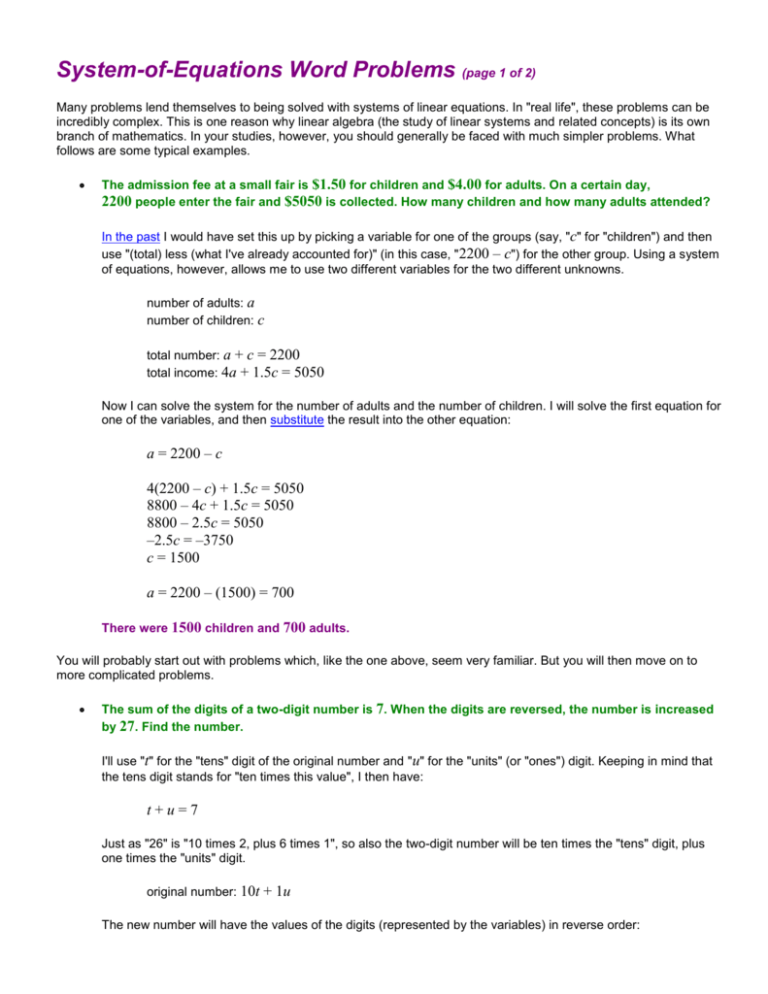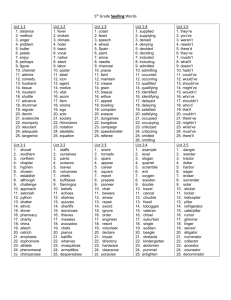
System-of-Equations Word Problems (page 1 of 2)
Many problems lend themselves to being solved with systems of linear equations. In "real life", these problems can be
incredibly complex. This is one reason why linear algebra (the study of linear systems and related concepts) is its own
branch of mathematics. In your studies, however, you should generally be faced with much simpler problems. What
follows are some typical examples.
The admission fee at a small fair is $1.50 for children and $4.00 for adults. On a certain day,
2200 people enter the fair and $5050 is collected. How many children and how many adults attended?
In the past I would have set this up by picking a variable for one of the groups (say, "c" for "children") and then
use "(total) less (what I've already accounted for)" (in this case, "2200 – c") for the other group. Using a system
of equations, however, allows me to use two different variables for the two different unknowns.
number of adults: a
number of children: c
total number: a + c = 2200
total income: 4a + 1.5c = 5050
Now I can solve the system for the number of adults and the number of children. I will solve the first equation for
one of the variables, and then substitute the result into the other equation:
a = 2200 – c
4(2200 – c) + 1.5c = 5050
8800 – 4c + 1.5c = 5050
8800 – 2.5c = 5050
–2.5c = –3750
c = 1500
a = 2200 – (1500) = 700
There were 1500 children and 700 adults.
You will probably start out with problems which, like the one above, seem very familiar. But you will then move on to
more complicated problems.
The sum of the digits of a two-digit number is 7. When the digits are reversed, the number is increased
by 27. Find the number.
I'll use "t" for the "tens" digit of the original number and "u" for the "units" (or "ones") digit. Keeping in mind that
the tens digit stands for "ten times this value", I then have:
t+u=7
Just as "26" is "10 times 2, plus 6 times 1", so also the two-digit number will be ten times the "tens" digit, plus
one times the "units" digit.
original number: 10t
+ 1u
The new number will have the values of the digits (represented by the variables) in reverse order:
new number: 10u
+ 1t
And this new number is twenty-seven more than the original number:
(new number) is (old number) increased by (twenty-seven)
10u + 1t = 10t + 1u + 27
Now I have a system that I can solve:
t+u=7
10u + t = 10t + u + 27
First I'll simplify the second equation:
10u + t = 10t + u + 27
9u – 9t = 27
u–t=3
After reordering the variables in the first equation, I now have:
u+t=7
u–t=3
Using substitution, u = 5. Then t = 2. Checking, this means that the original number was 25 and the new
number (gotten by switching the digits) is 52. Since 52 – 25 = 27, this solution checks out. Copyright © Elizabeth
Stapel 1999-2009 All Rights Reserved
The number is 25.
System-of-Equations Word Problems (page 2 of 2)
A landscaping company placed two orders with a nursery. The first order was for 13 bushes and 4
trees, and totalled $487. The second order was for 6 bushes and 2 trees, and totalled $232. The bills do
not list the per-item price. What were the costs of one bush and of one tree?
I could try to add the bushes and trees, to get 19 bushes and 6 trees, but this wouldn't get me anywhere,
because I don't have subtotals for the bushes and trees. So I'll pick variables (" b" for the number of bushes and
"t" for the number of trees) and set up a system of equations:
first order: 13b + 4t = 487
second order: 6b + 2t = 232
You need to solve for t in the 2nd equation: 1st divide both sides by 2. This gives you 3b + t = 116.
Solve for t : t = 116 – 3b. Replace the t in Eq.1 with 116 – 3b. 13b + 4(116 – 3b) = 487. Use the
distributive property, combine like terms, then solve for b.
This says that b = 23. Back-solving, I get that t = 47. Of course, the exercise didn't ask for the values of the two
variables. Translating back into English, the solution is: Bushes cost $23 each; trees cost $47 each.
You probably remember the "distance" problems where you had a boat going with and against the current or a plane
going with and against the wind. Once you learn how to solve systems of equations, you'll see more of these sorts of
exercises.
A passenger jet took three hours to fly 1800 miles in the direction of the jetstream. The return trip
against the jetstream took four hours. What was the jet's speed in still air and the jetstream's speed?
When they ask you about the speed "in still air" (for planes) or "in still water" (for boats), they are referring to the
speedometer reading; they are referring only to the powered input, irrespective of outside influences.
On some very windy day, you can watch birds flapping frantically in the air, trying to cross the street, say, from
the tree in your front yard. No matter how hard they flapped, they made little or no forward progress;
sometimes, a bird will even appear to "fly" backwards! Did this mean that the bird wasn't actually flapping? No; it
means that the bird's attempted speed (how fast the flapping would have moved the bird on a windless day)
was not fast enough to usefully counteract the wind hitting it in the face. The bird's "speed in still air", less the
wind's speed in the opposite direction, was close to zero, or even negative.
The same concept applies to machinery. If a boat's motor is chugging away at 10 miles an hour (according to
the speedometer), but the boat is facing a water current of 15 miles an hour in the opposite direction, then the
boat wi,l end up going backwards at five miles an hour. In other words, the speedometer reading is not always
the actual speed.
Returning to the exercise, I'll pick variables and set up a system. In this case, I'll use "p" for "the plane's
speedometer reading (apparent speed)" and "w" for "the windspeed". When the plane is going "with" the wind
(when it has a "tailwind"), the two speeds will add together; when the plane is going "against" the wind (when it
has a "headwind"), the windspeed will be subtracted from the plane's speedometer reading (that is, from the
engines' actual output).
In each case, the "distance" equation will be "(the combined speed) times (the time at that speed) equals (the
total distance travelled)":
with the jetstream:
(p + w)(3) = 1800
against the jetstream:
(p – w)(4) = 1800
Rather than multiply through, I notice that, if I divide off the 3 and the 4, I'll have a system that's already set for
solving by addition:Copyright © Elizabeth Stapel 1999-2009All Rights Reserved
p + w = 600
p – w = 450
Solve by choosing which equation to solve for p (or w).
I solved the 2nd equation for p:
p = 450 + w.
(450 + w) + w = 600. (I replaced the p in Eq. 1 with (450 + w) )
450 + 2w = 600.
2w = 150.
w = 75
(combine like terms)
(Solve for w)
(525, 75) is the answer
OR by adding down, 2p
= 1050 so p = 525, and w must then be 75.
The jet's speed was 525 mph and the jetstream windspeed was 75 mph.










